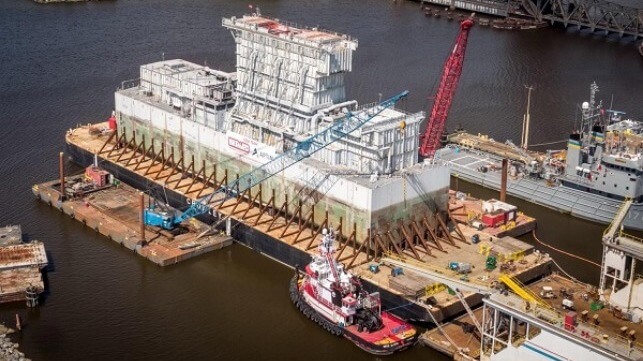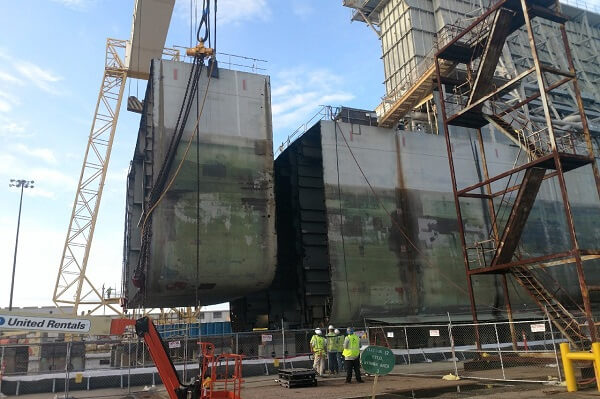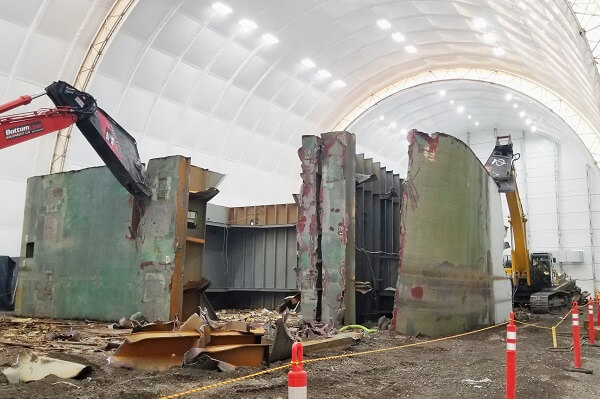End of an Era: Navy Completes Dismantling of Nuclear Ships Refueling Barge

The U.S. Navy is celebrating the completion of a complex and risky task of dismantling a barge that was formerly used for dockside refueling of nuclear-powered ships. The project was also considered a prototype for larger decommissioning efforts including the aircraft carrier U.S.S. Enterprise, which will start the Navy’s decommissioning of the first generation of large surface nuclear-powered carriers. Two other large carriers are scheduled to closely follow the Enterprise’s recycling effort.
The Navy announced that after more than three years, the task of dismantling the former Surface Ship Support Barge (SSSB) was completed last month by APTIM at the Alabama Shipyard. Until its decommissioning in 2016, the barge was an integral component of the Navy’s nuclear-powered ship maintenance efforts for more than five decades serving as the primary platform supporting the complex refueling, defueling, and associated maintenance operations for reactor components of the surface ships.
The SSSB began its life as the mid-section of a World War II-era T2 tanker built for the U.S. Government. In 1964, the vessel was converted to a nuclear support facility, initially called the Prototype Waterborne Expended Fuel Container (PWEFC). In the late 1980s, PWEFC was refurbished with significant upgrades that included replacing the original hull and tank structure and installing new longitudinal bulkheads. A decade later, the Navy completed additional repairs and upgrades, extending the platform’s service life by 50 years, and renamed her SSSB.
Over a period of 52 years at the Newport News Shipbuilding, the 268-foot barge that was in the Navy vernacular known as “Triple S-B” supported the defueling operations of nuclear-powered cruisers and aircraft carriers like the Enterprise. SSSB was also instrumental in extending the service lives of many other nuclear-powered warships as part of their midlife refueling and complex overhauls.
In 2016, SSSB was decommissioned with the process of its dismantling and disposal commencing in June 2020 when the Navy awarded a three-year contract worth $129 million to APTIM to carry out the task at the Alabama Shipyard with the support of Navy experts.

The barge was prepared for dismantling by the Navy which removed all the fuel. However, one percent of the platform’s low residual radioactivity contained in the spent water pool and associated system components remained aboard and required careful remediation. APTIM took possession of the SSSB in Virginia and towed it 1,500 nautical miles on a heavy lift barge to Alabama, where it was removed from the water and placed on blocks for dismantlement.
For three years, APTIM’s team of hazardous remediation experts logged 237,389 hours to complete the dismantlement and disposal, working within a specially fabricated structure under strict environmental monitoring. APTIM was able to complete the process of demolishing the final components of the platform including the former spent fuel water pool, a 32-foot-deep compartment that comprised 2,500 tonnes of steel-reinforced, high-density concrete.
Other tasks included the methodical surveying, identification, and separation of hazardous waste components that were then packaged and transported for disposal at Waste Control Specialists, a regulated facility in Andrews, Texas. The Navy highlighted that approximately 8,080 tons of waste material were safely packaged and shipped to the facility and 426 tons of ferrous and non-ferrous metals were recycled.


that matters most
Get the latest maritime news delivered to your inbox daily.
The task of dismantling and disposing of the SSSB was completed in June with the dismantlement site handed back to Alabama Shipyard at the end of September, marking the completion of the project. The final report and contract closeout were expected to be completed at the end of October.
The U.S. Navy recently announced it will use a commercial shipyard in a similar project to dismantle the Enterprise. After a lengthy study that followed the SSSB project, the Navy reported that a commercial yard would be the most effective method for the retired Enterprise and not compete with its shipyard resources used to maintain the current fleet.
